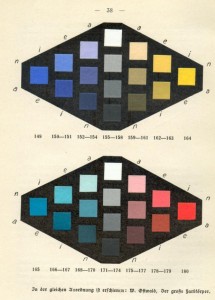Between science and art – a new thesis by Albrecht Pohlmann on Wilhelm Ostwald
is the title of a new doctoral thesis in German language by Albrecht Pohlmann, 1910, University of Halle.
It describes also Ostwald’s activities with the Bridge, the Munich "Institute for the Organization of Intelellectual Work" (Chapter 4. 2. 2) and contains some further chapters of interest also for media historians like chapter 8.3. "The copied image" and others.
Wilhelm Ostwald (1853-1932), who was awarded the Nobel Prize in Chemistry in 1909, is among the scientists who have devoted themselves to the principles of visual design. This dissertation comprehensively represents, for the first time, the genesis of his colour theory in the scientific, art political, art historical and aesthetic context of its time. Since 1903 he devoted himself to painting technique, and finally, in 1914, he developed a colour atlas on behalf of the Deutscher Werkbund. His aim was to create an authoritative colour system as a means of understanding for artists, designers and architects, given the confusingly large amount of new colourants. Ostwald established a new theory of body colours based upon the four-colour theorem of Ewald Hering, which made it possible to measure colours in a simple manner. At the same time, from the organizing principles of his colour system (a colour solid in the form of a double cone) he developed a colour harmony. After World War I, he encountered protest of expressionist artists. Constructivists and functionalists took particular interest in his theories, such as with the Dutch ‘De-Stijl’ group, the Russian avant-garde movement and at the Bauhaus, where Ostwald taught in 1927 at the invitation of Walter Gropius. The main objective of his art technological research was to create a universal grammar of visual media in the era of the second technological revolution, hence his interest in photography, abstract film and picture transmission. The reproducibility of works of art appeared to him to be the requirement of a democratic society. His practical art technological experiments were embedded in a comprehensive art and media theory, which Ostwald had developed on the basis of his “Energetics” (1891) and his positivist “Philosophy of Nature” (1902).

